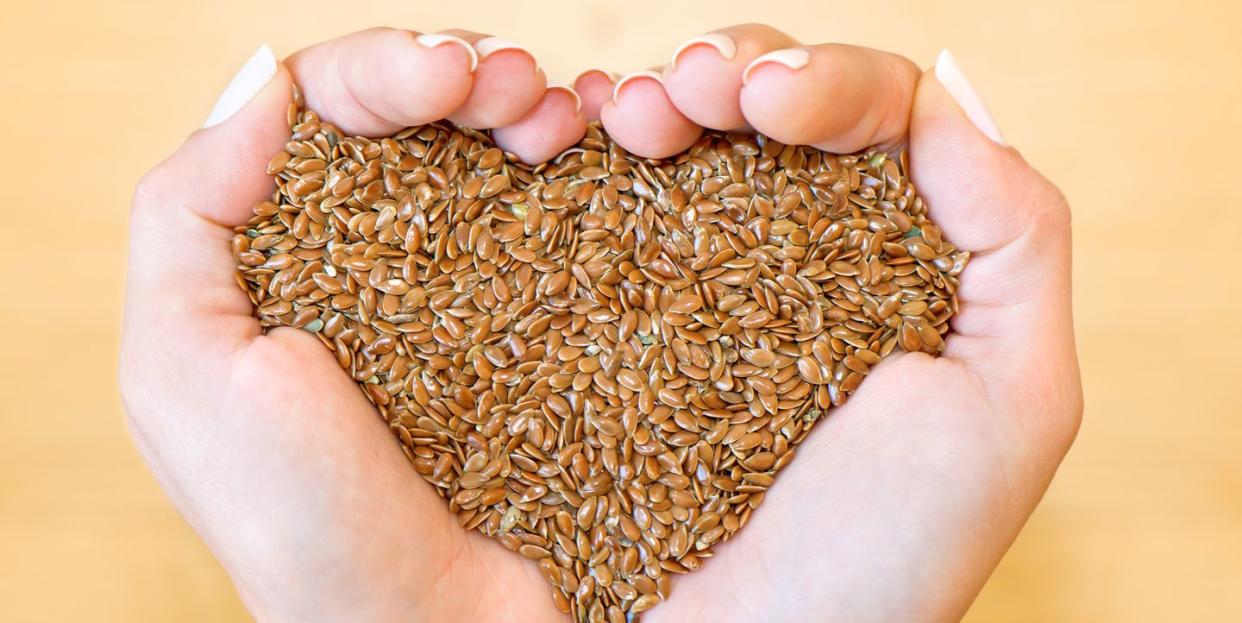Seed Cycling Could Impact Your Hormones and Menstrual Cycle, But Is It Worth It?

There are a number of health claims and alternative medicine regimes circulating the internet — some good, some bad. Like any health care decision, it's best to consult a medical professional before significantly altering your diet, exercise routine, or anything else. It's also beneficial to educate yourself on specific medical claims, especially when it comes to menstruation health. So if you've heard of "seed cycling" and have felt intrigued, confused, or a combination of both, know that you're not alone. It can be difficult, if not nearly impossible, to wade through the plethora of information about this alternative practice.
Seed cycling refers to the practice of ingesting certain types of seeds during the course of your menstrual cycle to help support hormone balance. And it is thought to produce significant outcomes. “If you have irregular periods, painful periods, PMS, heavy flow, menopause symptoms, PCOS, endometriosis, or are coming off of birth control, then seed cycling might be for you,” Dr. Jess Peatros, MD, tells Woman's Day.
While there isn't a significant amount of research on the purported benefits of seed cycling and how it may or may not impact your hormones during menstruation, many people who use this method to curb period pain swear by it.
So let’s take a deep dive into what seed cycling is, how it works, and whether or not it's for you.
What is seed cycling?
“Seed cycling is the use of specific seeds during different phases of the menstrual cycle to help promote hormone imbalance,” Dr. Aumatma Shah, founder of the Holistic Fertility Center and medical advisor at ELLEMENT, tells Woman's Day. In a nutshell, you ingest four types of seeds throughout the course of your cycle to mitigate the symptoms of menstruation.
During the follicular phase, which typically falls on days 1-14 of your cycle, you ingest a tablespoon each of ground flax seeds and ground pumpkin seeds. During the luteal phase, which typically falls on days 15-28, you ingest a tablespoon each of ground sesame seeds and ground sunflower seeds.
According to nutritional medicine, these specific seeds are high in specific nutrients that reportedly help balance out the progesterone and estrogen that your body produces during your cycle. “Both estrogen and progesterone are involved in women’s cycles,” Peatros explains. “These two hormones are delicate and easily imbalanced with nutrient deficiencies, stress, the standard American diet, hidden pathogens, an unhealthy gut or permeable gut membrane, and even thyroid dysfunction. An imbalance in estrogen and progesterone can contribute to irregular cycles, a lack of a cycle, painful periods, and PMS.”
How does it work?
Flax, pumpkin, sesame, and sunflower seeds all contain lignans, which are thought to mimic the effects of estrogen in the body. “We’ve always thought of flax as mildly estrogenic in naturopathic,” Shah says. Flax is also high in omega-3s and fiber. “We believe the fiber helps bind and block excess fiber,” Dr. Jordan Wiggins, ND, tells Woman's Day. Pumpkin, on the other hand, is high in zinc and is believed to help support progesterone production and the release of the egg — which is the goal of the follicular phase.
Sesame and sunflower seeds, which you ingest during the luteal phase, have different nutrients that support your body as you enter the second phase of your cycle. “Sesame helps block estrogen,” Wiggins explains. “It’s common for women to be estrogen-dominant, and if there is high estrogen in the second half of the cycle, it could lead to painful, heavy periods.” Sunflowers are high in vitamin E, which is thought to help with hormone balance.
What are the benefits?
Research on seed cycling is practically non-existent, save for a handful of studies on pumpkin, flax, sunflower, and sesame seeds. And the results of those studies are mixed at best. There is, however, anecdotal evidence from those who engage in seed cycling and believe that it works.
“Seed cycling is great for younger women with irregular periods because it can help regulate them,” Wiggins says. “Those with conditions such as endometriosis, PCOS, and heavy, painful periods may see an improvement in their symptoms, too.” Wiggins also claims that seed cycling can help folks who have significantly shorter or longer periods than the average menstruating person, because the hormone balance they promote can regulate your cycle.
“It’s like a natural multivitamin for your cycle,” Shah continues. “It’s a great supplement to other treatments for conditions such as endometriosis and PCOS, as well as a supplemental boost for those trying to regulate their cycle to get pregnant.” Most folks see results within 4-6 weeks of starting seed cycling, according to Peatros.
What are the risks?
While there are no inherent risks to seed cycling, it’s always a good idea to check in with your doctor before starting anything new. And Shah is quick to stress that you shouldn’t look to seed cycling as a cure-all for serious medical issues, or as a replacement for more tried-and-true treatments.
“I see this come up a lot where women will say, ‘I’ve been seed cycling for eight months and I’m still not pregnant,’ and it’s because that’s not really what it’s for,” Shah explains. “The little bit of realism is important, and we should recognize that there are things we do to maintain balance in the body, and then there are things that help step up the process. All major conditions need more focused attention.”
Subscribe to Woman's Day today and get 73% off your first 12 issues. And while you’re at it, sign up for our FREE newsletter for even more of the Woman's Day content you want.
You Might Also Like